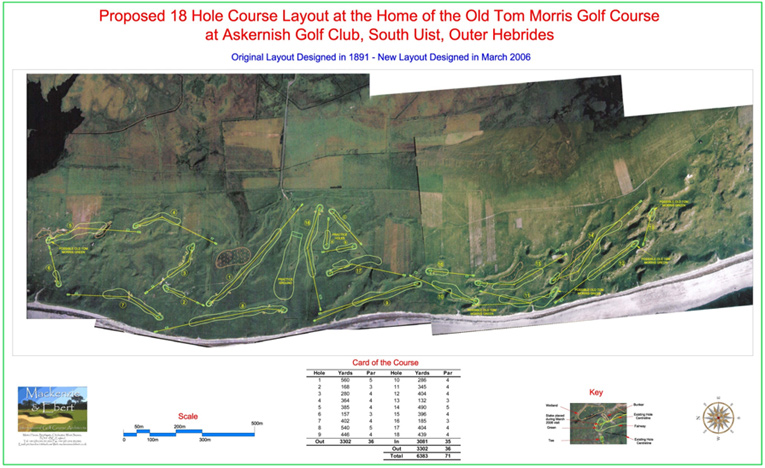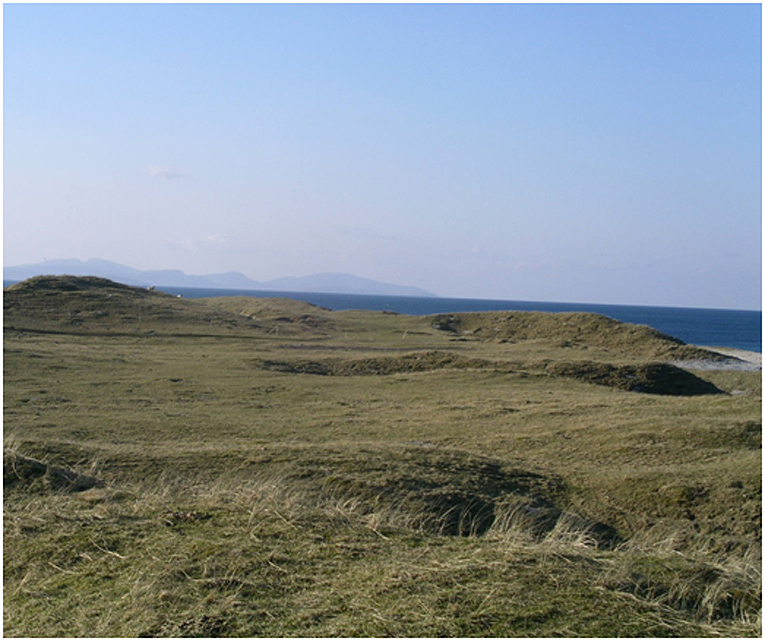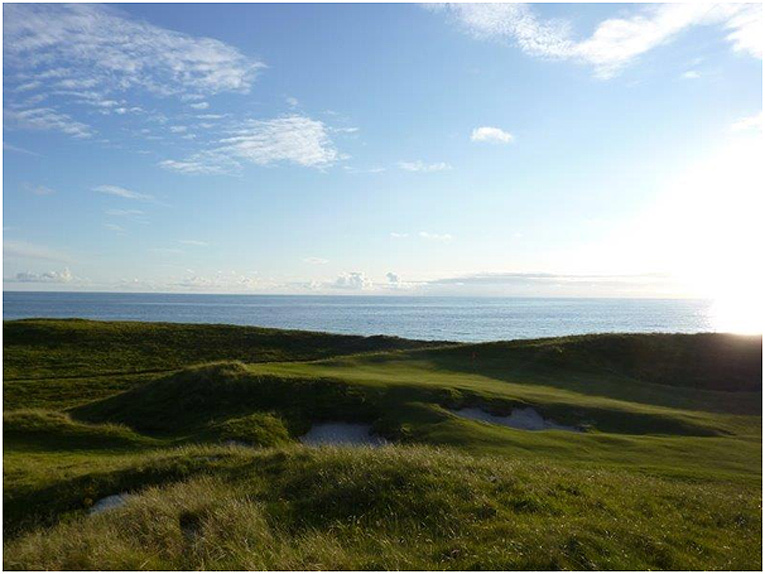Feature Interview with Martin Ebert &
Ralph Thompson
July 2013
1. The Askernish Golf Club literature talks about Old Tom Morris and Horace Hutchison designing the course in 1891. Yet, no records or photographs exist. There were hints of a green here and there, maybe a tee or two but back then, minimal earth was moved. Discovering much was impossible. What was your first step?
Martin Ebert (ME): You are right in that it was difficult to assess where greens, tees and fairways were located. However, the dunescape is so dramatic we had to think that where relatively flat areas existed they were either natural green locations or had been shaped or softened in shape to produce greensites. So the initial exercise was largely one of finding as many greensites as possible and then trying to link them up in a sequential routing. This was carried out during the first two day visit to Askernish in March 2006 and, the day afterwards, four of the Askernish members played the course.
The initial routing exercise was a team effort involving myself, Ralph Thompson, Gordon Irvine, Chris Haspell, Adam Lawrence and the then Course Manager, Colin MacGregor. All contributed to a larger or lesser extent and I put down the layout on the aerial photo. That accounted for today’s 1st, 2nd, 3rd, 5th fairway and green, 6th (although the green position has changed), 7th, 8th, 9th, 10th, 14th green (played from behind the 10th green), 15th (although there were plans to play it as a par 5 across wetland to a green which would have needed to be raised slightly), 16th (although the green was originally the pimple of the approach rather than the hollow which I preferred and where it is now located), 17th (to a green to the right which I did not favour and now it is in the location I originally preferred) and the 18th tees and fairway location.
The layout exercise was carried out imagining the principles which Old Tom would have followed. As with so many of the great links the coastal stretch was not saved for the last few holes. Blind shots were considered acceptable. Multi route holes definitely kept in mind. Quirky greens absolutely fine. Crossing holes if necessary. Tees very close to previous greens wherever possible. However, we did have the modern aids of an aerial photograph, a rangefinder, a GPS unit and AutoCad to put down the results of the first day’s research and subsequent layout plan.
However, that did not affect the fundamental and traditional method of planting stakes for tee locations dogleg points and green centres by the end of the two days.
2. Any particular hurdles along the way?
Some crofters made objections with the land to the north so some holes were dropped out from there. Gordon Irvine, over on a visit to help assist with the improvement of playing conditions, suggested the current 4th, 5th tee, 11th (he was worried it was too tough but it has turned out to be one of the great holes), a narrower (right hand route only) 12th but was then having difficulties getting back to the 14th green. I made another visit in May 2007, confirmed the 11th, widened the 12th to be multi route and took the 13th around a sand hill to reach the current 14th tees. Gordon also located the 18th green at this time.
3. Holes 1-6 are over fine links land and then you climb up to the seventh tee and WHAM! You are in the biggest dunes on the course and over the next 10 holes, the golfer goes on perhaps the greatest roller-coaster rides that the game offers. Talk with us about the routing process and what were the key moments – the seventh tee? The jaw-dropping ninth green complex? Turning the twelfth hole inland away from the Irish Sea?
ME: There were numerous options for holes 1 to 6 but, as you say, when the 7th is reached the hole just sits out there before you. The same was the case for the 8th, 9th and 10th holes. The par 3 11th is a tough prospect today and might have been considered an impossible playing challenge in 1891. However, the hole works and, getting to the far south end of the area available at the time, it was time to turn inland with the multi route par 5 12th hole. While the sea views become more distant for the 12th to 18th holes, the inland views are stunning as well and the dunescape equally ideal for golf. These holes are more than a match for the coastal stretch with only the 18th receiving the odd comment that it produces a quiet finish but I believe it is one of the unsung holes with its dogleg around the old cattle pen and to a green with some excellent contours.
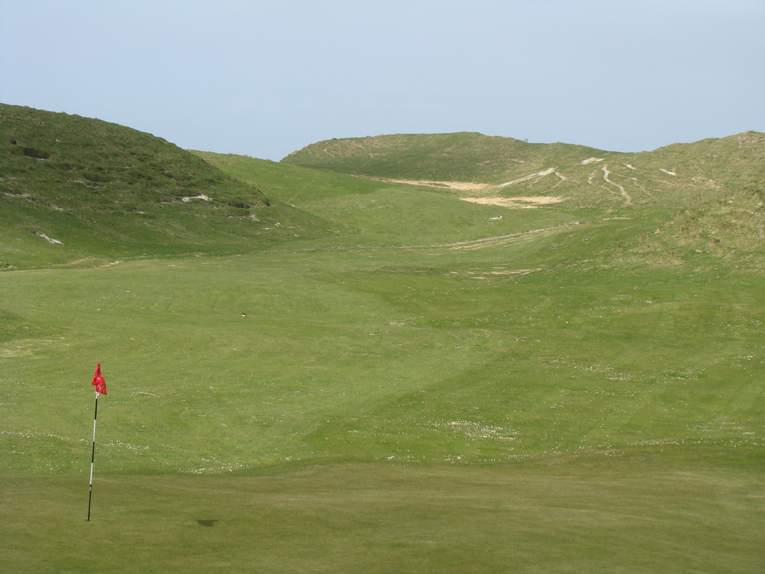
This view from the seventh green back up to the tee is a clear indication of the wild terrain that the golfer has now entered.
4. As you roamed over the 300 acres, how and when did you spot the future punchbowl fifteenth green location?
ME: As mentioned above, the 15th hole was initially planned to play as a par 5 with a green set beyond a low, wet dune slack, reminiscent of some of the marsh holes at Royal West Norfolk. However, the green would have needed to have been raised by a foot or two to keep it dry throughout the year. Hence Gordon Irvine and the greenstaff cut out the existing 15th green in the hollow short of the wet lowland and, I have to say, it makes for a great old fashioned green.
5. Tell us about the course construction technique. What equipment was used? How were the fairway grasses cultivated?
ME: The course was basically brought into play by mowing of the greens and fairways and gradually fining down the grasses. Initially fairways were cut using a gang mower but Ransomes Jacobsen kindly supplied a fairway mower, rough mower, pedestrian mowers for greens, a Cushman and top dressing unit. Rabbit damage was a major issue and continues to be a challenge which is being slowly won. Turf (sod) was stripped from the obsolete greens from the 9 hole course and used to repair the rabbit damage. Small tees were constructed by hand. The 7th green has been reshaped and turf was stripped from the 6th and 15th greensites to allow rabbit damage to be repaired and levels to be adjusted very slightly.
6. Is that light touch on the land coupled with no irrigation what made permitting to work in the dunes even possible?
ME: The fact that there was a golf course on the land in previous times and that there was still a 9 hole course in play established a precedent for golf on the links. However, an ecological management plan had to be produced and submitted to conserve the ecological attributes of the site. The absence of irrigation, application of chemicals and the general maintenance principles undoubtedly assisted with the permission for the course to be restored and played although the rights of the crofters had to be considered and respected during the process.
7. Askernish represents the ultimate in natural golf. Give us an example of a green and the process to transform it into a putting surface.
ME: The key to the green conversion process was to respect the levels of the greensites completely wherever possible. A good case in point would be the 9th green which sits at a great angle perched on its ledge with banks in front and behind and with wonderful undulation. There was rabbit damage on this green so this had to be repaired (more than once) during the mowing programme. Gradually the heights of cut have produced the green surface we have today. This was helped with an overseeding programme and top dressing with local root zone from the obsolete greens from the 9 hole course. Subsequently the top dressing material has included milled seaweed from the beach and some organic fertiliser in the form of dried blood, hoof and horn has been applied to greens only (fairways have not received any fertiliser). The greens keep their natural look but, I would say, putt much more smoothly and quickly than they look.
8. The greens feature some of the finest/boldest interior contours in the golf world. What is their optimal green speed?
ME: I would say that the optimal green speed would be around 8. It is difficult to mow them tighter – the lowest they are cut is 6m. If they are mown much tighter the sharper contours might scalp and the natural grasses would be in danger of dropping out. The contours would make some of the greens too severe at higher speeds. With a speed of 8 the greens can be presented to play with more speed by selecting the majority of flag positions in low parts of the greens.
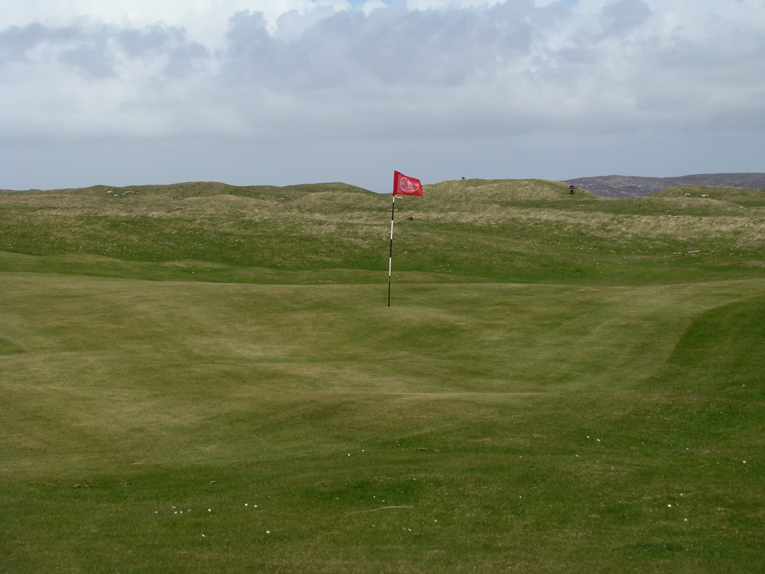
Speed becomes far less important when interior contours exist like the ones found at the second green. The back right hole location is two feet lower than the challenging one seen above.
9. How many people are on the greenkeeping crew? How is the course maintained?
ME: Since the start of construction the maintenance crew has numbered two in total but is now one full time (Allan MacDonald) and one part time seasonal greenkeeper. Allan deserves great credit for turning the course out so well. Over the years, parties of unpaid volunteers have spend a week or two helping with specific projects. That has been extremely helpful. With such a small number on the maintenance crew you can imagine that the maintenance programme is basic and limited to cutting and top dressing. No irrigation is applied and no fungicides or pesticides are used.
10. There are four bunkers on the course. How did each come to pass?
ME: I remember a Golf Club Atlas post where a contributor criticised the man made addition of the lacey edged bunker at the 12th green. That was a completely natural bunker, or was at least formed by cattle sheltering from the elements! The other bunker which existed was in the approach to the 11th green, again a natural phenomenon. The two bunkers at the 8th green were in the sandy hollows which had become a dumping ground for rubbish. In clearing them out the decision was taken to turn them into bunkers.
11. Would a few additional bunkers make the design even better? If so, are there any choice potential future bunker locations you can share with us?
ME: This was a subject which I debated with Tom Doak when he made his one visit in September 2010. He felt that it would not be the right thing to add more bunkers. I am inclined to agree that the course has so much great natural undulation and feature, especially around the greens, that bunkers are superfluous. However natural bunkers are made to look, there might be an element of them being added to what is golf over completely natural terrain.
12. How did Tom Doak come to get involved? What did he and Eric Iverson do?
Ralph Thompson (RT): I had been in touch with Mike Keiser from almost the start of the restoration project and he asked Tom to come over and have a look at any possible improvements that could be made to the routing. Tom came over and met with Martin Ebert and we had long long conversations about possible small changes. We eventually agreed on a couple of minor tweeks to the 7th and 16th greens and a new tee at the 6th and Eric Iverson came over and did the works. Mike Keiser generously provided the funds.
13. The course opened for play in 2009. Other than Eric’s work, what tweaks have you done to the course?
ME: First of all I will just explain the excellent work which Eric Iversen carried out and how it was conceived.
Eric’s involvement followed Tom Doak’s visit in September 2010 (commissioned by Mike Keiser). Tom spent a weekend at Askernish playing a few rounds and I arrived on the Monday and we had just enough time for a 3 hour speed walk around the course looking at every hole and debating if any adjustments should be made. Tom was refreshingly impressed by what he found and it was excellent to hear later that he regarded the course the most notable he had seen that year. He made some very useful points for the business approach of the operation and specific comments regarding some of the holes. However, I was surprised that he wanted to make as much change to the natural levels of the 11th approach and he also wanted to reshape the 16th approach and green entirely.
I was adamant that a smaller scale operation be implemented at the 11th and that the major surgery to the 16th green should not happen. To me the 16th green is one which provides great debate and memory and to reshape it (and I have no doubt Eric would have done a great job) would take away from the essence of Askernish. I do not feel that it lets the course down at all but Tom seemed to think that it did. In the end we made a minor extension of the green at its rear. The 7th green has been adjusted twice, once by Gordon Irvine and then again by Eric in January 2011 with my input. Eric made the minor adjustments to the 11th approach, carried out the extension to the rear of the 16th green and shaped up the 17th green, again with my input.
Following on from this there have not been many changes apart from the movement of the 6th green twice, each time to the right, closer to the sea, the first time as suggested by Tom Doak. Initially it was felt that sand blow would be a major issue in getting too close to the coast. These fears have dissipated but could return. The green surface will now be in view from the fairway whereas it was originally an awkward, blind shot up an over a bank to an away sloping green.
14. Askernish has at a minimum six all-world golf holes – the 7th, 8th, 9th, 11th, 12th, and 16th. Pebble Beach has the same number so you are in good company. Beyond those six, what is a favorite sleeper hole, one that a first time visitor might not appreciate until after his fifth or tenth round?
First of all I would add the 14th and 15th to your list of all-world golf holes and maybe the 10th as well. However, as far as the quieter holes are concerned I would put forward the par 3 2nd hole (made by the ridge back green) and, in terms of appreciation dawning after the 5th or 10th round I would go for the 18th hole.
15. Please expand. You note above that the Home hole is underrated yet some consider it is a curious closer as it finishes well away from the car park.
ME: The initial plan had a 17th hole playing as a par 4 for the first part of the current 18th hole. The 18th then played from a tee near the current 7th tees giving a final view over the ocean before playing back as a long par 4 towards the clubhouse. When the layout had to be changed by dropping some of the original holes to the north and be replaced to the south, the 17th was extended to become the 18th. Gordon Irvine conceived the extension to the current greensite and I think it works well. The walk back to clubhouse and car park gives an opportunity to mull over the great shots, the missed putts and an appreciation of the great round which has just been experienced.
16. How has the development of the course been funded?
ME: As mentioned above, a lot of the work has been carried out by willing volunteers who have not charged anything for their input. Visits by teams of greenkeepers have been organised by Gordon Irvine, we have provided architectural advice for the same fee as Old Tom Morris – Ten shillings a hole which equates to £9 or around 15 US dollars! Ramsomes Jacobsen have provided all machinery at no cost. The R&A made a grant to assist with the development of junior golf but the major funding for the initial work to the course was donated by Gordon Stollery from Canada. He was a client of ours (We designed a new course for him at Goodwood, north of Toronto and are about to redesign the South Course at Angus Glen for his daughters led by Cailey Stollery as Gordon sadly passed away around 18 months ago). Gordon was in the oil business in Canada, loved links and natural golf, developed Angus Glen with his father, Art, was a member of The R&A and loved the concept of Askernish. Subsequently, Mike Keiser has funded the work carried out when Eric Iversen made his visit. Apart from that, Life Memberships have allowed Askernish to operate. All of this process has been coordinated by the Askernish stalwarts of Ralph Thompson, Donald MacInnes and Angus McIntyre and the other local members but they do have the benefit of enjoying the course day in and day out!
17. Tell us about the business model. To whom is Askernish meant to appeal? Does Askernish accept members? Other than green fees, will other revenue sources exist like food/beverage/lodging?
RT: Askernish Golf Club is a Community Interest Company Limited by Guarantee and all its assets are locked for community benefit. We have about 150 members most of whom are Country Members from out with the island who pay a nominal fee each year to share full member benefits. They are largely links golf fanatics who love the natural and informal feel of Askernish. We just constructed a large shed to house the maintenance equipment and to incorporate an indoor practice area which will allow us to continue the coaching sessions for children and beginners throughout the winter. We also now have mains electricity to the clubhouse and have employed a lady to provide full catering facilities throughout the season. This is an important revenue stream for the club. The practice facility has been designed so we can incorporate functions like dances, birthday parties, weddings etc. which will provide much needed income.
18. Concluding thoughts?
ME: I hope that the above will give everyone a flavour of what Askernish is all about, how it has been achieved by so many willing volunteers, how good the course is both as a historical experience and as a great test of golf. I will once again be visiting to play in the Askernish Open at the end of August. The most enjoyable golf I have ever experienced. Hopefully Old Tom would approve of what he would find if he was able to return!
THE END


